www.moonlandings.co.uk
The Moon | Radiation & Van Allen Belts | A Void of Space | Space Cameras | Temperature | Photograph Anomolies
Space Cameras
Thirty years ago prospective astronaut Walter Schirra went into a photographic shop in Houston and bought a Hasselblad 500C with a standard Planar f/2.8, 80 mm lens. All the leather was stripped from the camera body and it was painted black to minimise reflections.
Onboard a Mercury spacecraft in October 1962, Walter Schirra took the first space photographs using a Hasselblad. Thus began the first page in a new chapter in the history of Hasselblad and photography.
It was only after seeing the quality of the photographs that it was realised just how important they were. NASA's photo department grew rapidly. It became a focal point for a string of experts including photo technicians, laboratory technicians and America's foremost photo interpreters. Liaisons were also established between diverse institutions that might be interested in pictures from space for a variety of reasons. Contact with Hasselblad broadened. Cameras were modified. Different lenses were tried out. A Hasselblad SWC with a Zeiss Biogon f/4.5, 38 mm lens was used for the first time on Gemini 9 in 1966. A Hasselblad 500EL had its debut aboard Apollo VIII, which made l0 orbits around the Moon. In July 1969 Apollo XI landed on the Moon with a Hasselblad 500EL Data Camera with Reseauplate fitted with a Zeiss Biogon f/5.6, 60 mm lens. The still shots from that mission have become more widely known than the film sequences. The 1980's were the era of the space shuttle. However, Hasselblad cameras are still used. On average, between 1 500 and 2 000 photographs are taken on each journey (adapted from the Hasselblad Web site)
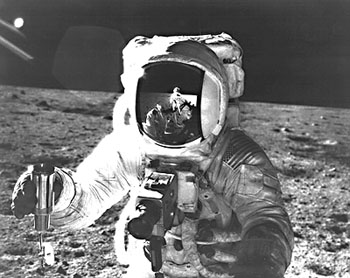
One of the Hasselblad 500 EL cameras attached to Buzz Aldrin on the Apollo 11 mission
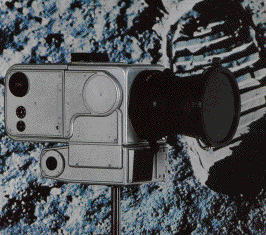
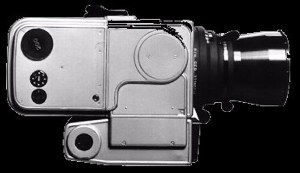
The Hasselblad Data Camera was on Apollo 11 and became the first still camera on the moon on 20 July 1969
Markings on the Photographic Images
The various Hasselblad cameras had a plate in the light path that superimposed references marks (very fine crosses) on the film. These are known as Fiducials. In NASA's text, the location of an object in an image is sometimes indicated by reference to the fiducials
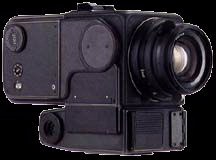
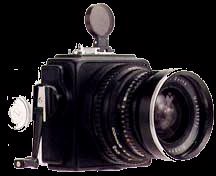
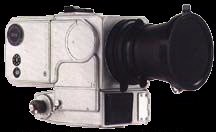
Above (left to right): Space Camera models EC, SWC and Spacedata EDC (Source)
The History of the Hasselblad Space Camera
In the middle 1960's, Kodak of Rochester, USA, was asked by NASA to develop thinner new films with special emulsions. Similarly, Carl Zeiss of Germany were busy investigating whether the optical characteristics of lenses changed in vacuum.
At Hasselblad the shutter was modified. Lubricants had to be chosen with utmost care because of the risk that conventional lubricants could boil off in vacuum and condense all over the optical surfaces of the lens.
A tragic accident ensued in 1967 when the three man crew of Apollo 1 was suffocated by poisonous fumes generated by burning wire insulation and other synthetic materials in the space capsule.
This led to a further stiffening of technical specifications for the moon camera. Synthetic materials were to be avoided. It was absolutely essential that any such materials should first be tested and approved by NASA. The already tight schedule came under even greater pressure.
There was also a call for some means of taking sequences of pictures in space. These were to be taken at uniform short intervals. In 1965 Hasselblad had launched its EL camera and the following year discussions began on the possibility of modifying this model to take sequences of photographs in space. These plans now came to fruition. Development pushed ahead and in June 1967 a contract was signed between NASA and Hasselblad.
The specifications for the Moon camera were finally settled in September 1968. A completely new lens was designed by Carl Zeiss. This lens would have a maximum aperture of f/5.6 and a focal length of 60 mm. Naturally it had to exhibit minimal radial and tangential distortion. The design was not complete until February 1969. The finished cameras for Apollo 11 were delivered by Hasselblad on 1 March 1969.
On board Apollo 11 was the so-called Moon camera plus two 'standard' space cameras. Before the trip the magazines were loaded with 70 mm film on open spools. This permitted some 200 exposures per roll. The magazines had to be loaded in a darkroom. A short series of test shots were then taken of a test screen with these exposures appearing at the start of each roll. After processing, these frames were cut out and developed as test strips to identify any defects at an early stage so that processing time could be corrected.
When Armstrong and Aldrin finally landed The Eagle on the surface of the Moon they had just enough fuel for a further 15 seconds manoeuvring. Meanwhile, in the Command Module Columbia, pilot Michael Collins continued to circle round and round the Moon. He completed 30 orbits at a height of 96,500 metres above the surface and managed to take a series of spectacular photographs using the two Hasselblad cameras.
Six and a half hours after landing on 20 July 1969, Neil Armstrong was first to step onto the surface of the moon. Twenty minutes later Edwin Aldrin followed him out. In one hand each astronaut carried a book that told them what they had to do, minute by minute. The two astronauts set out a seismometer, a solar wind screen and an American flag, which was made to 'flutter' by means of a steel wire. The Moon has no atmosphere and therefore no wind.
Neil Armstrong took the photographs. As commander he was also assigned as photographer and instructed to take photographs of anything that appeared interesting. He shot a total of 3 magazines containing just over 150 frames each. Many of the pictures are uninteresting to most of us but a surprising number can be counted to have historical value. For example, when Armstrong made the first footprint he bent forward to take a picture. The camera was actually mounted on the chest of his space suit. Naturally he was unable to bring the camera to his eye to compose a shot in the normal way. The camera simp]y pointed where he turned his body.
Each time he made an exposure he told Houston that "I am taking a photograph now". Down on Earth, ground control made a note of the time so that they could keep track of how many pictures were taken. Armstrong himself could not see the counter on the camera.
Because the landing procedure had taken so long, Armstrong and Aldrin were already short of time when they landed. Despite these circumstances Armstrong succeeded in obtaining photographs that were not only technically good but even managed to communicate some of the grandeur of the occasion and of the exposed feeling of being in space. The astronauts also had the task of collecting samples of Moon rock to bring back to Earth. They brought back 25 kg of dust and rock which was well packed in specially made boxes. When Eagle left the moon after its 22 hour visit the Moon camera was not on board. It was abandoned, along with a whole pile of other equipment.
When the CM and its Apollo 11 crew returned to Earth the astronauts and the film magazines were put into quarantine. However the exposed films were among the first items to leave quarantine. They were treated with ethene gas, a powerful bactericide.
One can imagine the air of excitement when the films were removed from the magazines and the test strips were processed. The test strips were then compared against Kodak's accurate colour charts. Then the astronauts were asked what colour the Moon had been. Each had a different opinion and recollected differing impressions of what they had seen.
There was great tension before the film was developed. The stresses that a camera must withstand during such an adventure as this are exceptional and do not compare with any photographic situation on Earth. The temperature on the Moon reaches 134°C when the sun is at its zenith. When the photographs turned out to be so good that they would not only go down in photographic history but also appear in every historical publication that portrayed the modern age.
In total, 12 cameras were left on the Moon between 1969 and 1972. They are still there now.
The Lunar Camera:
Its official name is the Hasselblad Data Camera (HDC). NASA described the camera as follows in its equipment list:
"The Hasselblad Data Camera (HDC) is a rugged version of the commercial electric Hasselblad camera, 500EL, and is used for medium resolution, photogrammetric photography during the Apollo and Skylab missions. This camera incorporates a glass reseau plate positioned immediately in front of the flm plane. The reseau plate places a pattern of precision crosses on each photograph to facilitate photogrammetric utilization of the photography". The HDC weighed 1,4 kgs. The lens was a 60 mm f/5.6 Zeiss Biogon. Loaded with 70 mm thin base flm the capacity of the magazine was 170 frames. A colour magazine of Kodak Ektachrome SO168 - 160ASA was used during the EVA by both astronauts. The film used ('HCEX') is described as 'High Speed' by NASA in their Web site Glossary.
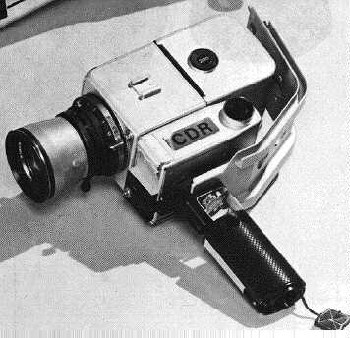
The Apollo Hasselblad 70mm still camera was mounted on the chest pack (PLSS RCU) with the bracket shown attached to the handle in this picture. It was also used to mount a carrier for the sample bags used on the surface. The camera was electrically powered. There was no viewfinder. The astronauts practiced extensively on how to aim the camera and set the focus and aperature settings. The CDR sticker on the side, which was orange with black letters, denotes that this camera would have been used by the Commander of the mission
Space Photography
The Apollo Program is an umbrella label that actually includes the Gemini, Skylab and Apollo-Soyuz Projects. The first two Apollo manned missions, Apollos 7 and 9, were confined to low earth orbit. Apollo 7, in 1968, commanded by Wally Schirra, was the first flight test of the Command and Service Module. During the 11 days in orbit, the crew took about 500 photographs of Earth, again using colour film in Hasselblad cameras.
Although of excellent quality, the Apollo 7 pictures were never subjected to detailed analysis because of the tight flight schedule involving the first lunar trip in Apollo 8.
The Apollo 8 mission, famed for its broadcast of greetings on Christmas Eve as the Moon was being circled, was something of an improvisation to test the Saturn V launch vehicle before the Lunar Module was ready for flight. Another goal was to ensure that the Soviet Union's Zond spacecraft did not make the first lunar mission (see Shepard and Slayton, 1994) . As the first manned mission ever to reach escape velocity, it had enormous impact worldwide. The hand-held 70mm photographs, including the first colour pictures of the Earth rising fromthe limb of the Moon, were truly historic. Scores of lunar surface photos were taken and, although coverage was sporadic compared to the pictures from the five Lunar Orbiter missions, they proved fascinating to the public and scientists alike.
The first manned flight of the complete 'stack', ie Saturn V with all components or stages, was the low earth orbit Apollo 9 mission. After completing tests of the Lunar Module, the crew, commanded by Col. J.A. McDivitt, acquired more than 1100 70mm colour photos of the Earth using single hand-held cameras.
Furthermore, they carried out a film rehearsal of ERTS, employing coaxially-mounted 70mm cameras with colour and black & white film to produce multispectral terrain photographs as part of the S065 experiment (Lowman, 1980).
The Apollo 9 mission was the most productive flown to that time, yielding superb pictures, some of which to this day have not been surpassed as records from space of certain areas. It has been suggested that Earth's atmosphere was actually clearer in 1969 than when Shuttle missions began some years later. For example, the Amazon Basin, a "blue ocean" in the words of the Gemini 9 astronauts, was by the 1990s generally obscured by smoke rising into the atmosphere from extensive land clearing.
Collectively, the deep space Apollo views of Earth have been credited as a major force in stimulating the environmental movements of the 1960s and later by reminding us of the incredible isolation of this blue and white planet in the blackness of space.
The six Apollo lunar landing missions also returned enormous numbers of photographs of Earth's satellite from lunar orbit and on the Moon's surface. A good collection of these was published by Masursky et al in 1978.
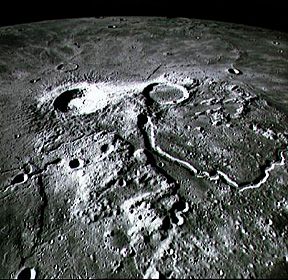
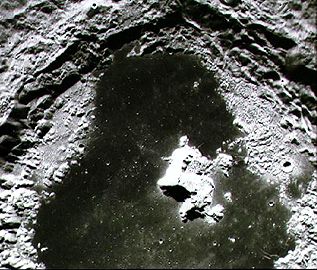
Two Apollo 16 examples: an oblique photo that shows the impact crater Aristarchus (left) and a neighbouring crater (right) of probable volcanic origin, as attested by its lack of central peak and terraces, the large (Schroeter's) rille traced to it, and a near vertical close-up of Tsiliokovsky Crater on the lunar farside
The very last 'Apollo' mission was flown in 1975, involving the first link-up with a Soviet spacecraft (Shepard and Slayton, 1994). Although flown partly for political reasons, the ASTP mission generated a notable volume of useful scientific data both from on-board experiments and from photography. Experiment MA-136, under the direction of Farouk El-Baz, was rather more elaborate than previous 70mm photography. In particular, it involved the astronauts more in making judgmental selections of targets for visual observation, drawing upon the Apollo lunar experiences which had further demonstrated the value of the human eye. There was also a substantial programme of ground (and water) truth data collection. Because of the high latitude of the Soviet launch site, the ASTP mission involved a high inclination, 51.8, orbit that broadened the scope of regional coverage.
Some 2000 pictures were taken, about 750 of these of good quality (eg not cloud-obscured). Objections were diverse, covering geology, oceanography, and meteorology.
Spin-off effects of the Apollo Programme on the development of the space camera
The tough requirements of NASA led to a general refinement of camera mechanics and a surge in development. For example, Hasselblad became one of the first to use Teflon coating on metal to reduce friction. The magazine design was changed to accommodate the new thin films. Work on incorporating the 'Reseau plate' later resulted in the development of a special Hasselblad camera for photogrammetry.
Bringing us up to date, Hasselblad launched a completely new camera, the Hasselblad 205TCC. The space version is called the Hasselblad 205AB. (More photographs of Hasselblad cameras)